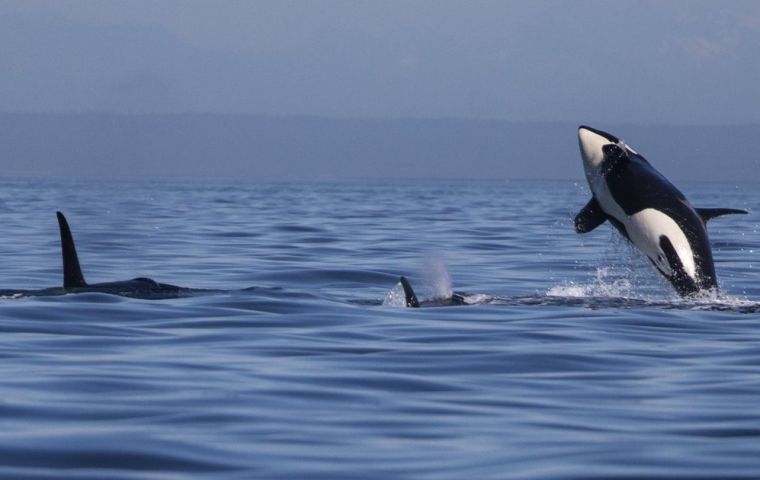MercoPress. South Atlantic News Agency
Antarctic tour vessels help solve killer whale mystery
 The ‘Type D’ killer whale is characterized by a more rounded head sharply pointed dorsal fin and much smaller eye patch than those of killer whales in Antarctica
The ‘Type D’ killer whale is characterized by a more rounded head sharply pointed dorsal fin and much smaller eye patch than those of killer whales in Antarctica Scientists finally come face to face with elusive mammals after years of research into a theory about ‘Type D’ killer whale in sub-Antarctic waters
Photographs taken aboard International Association of Antarctica Tour Operators (IAATO) vessels since the 1990s have supported research which, this year, has brought scientists face-to-face with a mysterious and potentially new species of killer whale.
An international research team led by Dr Bob Pitman, a researcher from NOAA Fisheries’ Southwest Fisheries Science Centre in California, has been compiling and cataloguing killer whale images as part of a project to monitor their distribution, movements and abundance.
The ‘Type D’ killer whale is characterized by a more rounded head sharply pointed dorsal fin and much smaller eye patch than those of killer whales elsewhere in Antarctic waters; and has been at the centre of a mystery spanning decades. Was it a different species of whale, or simply a genetic abnormality of a single, family pod?
In January this year, during a three-week research voyage near Cape Horn off Southern Chile aboard the 24m IAATO research vessel S/Y Australis, Pitman finally came face to face with the elusive animals that he has spent 14 years searching for.
The Australis encountered a group of approximately 30 whales which approached the vessel several times allowing the international team of scientists to capture vocalizations, underwater images and, most importantly, three biopsy samples; tiny bits of skin collected harmlessly using a dart.
With support from an anonymous donor through IAATO associate member Cookson Adventures and in collaboration with Centro de Conservación Cetácea, Chile, Dr. Ptiman's international team of experts included Professor Lisa Ballance from the United States, John Totterdell and Dr Rebecca Wellard from Australia, Dr Mariano Sironi from Argentina and Jared Towers from Canada.
Unraveling the secrets of these enigmatic animals now moves from the Southern Ocean to the laboratory, where NOAA scientists will analyze DNA from the skin samples.
“These samples hold the key to determining whether the Type D represents a distinct species of killer whale” Pitman said.
Although three other types of Antarctic killer whale have been well documented, good sightings of the elusive Type D are rare. From their data Pitman and his team surmise that the Type D killer whale is distributed around the entire continent of Antarctica, but avoids the coldest waters; leading them to suggest a common name: ‘Sub-Antarctic killer whale’.
Given that these waters are in some of the most inhospitable latitudes on the planet, it is no wonder it is almost unknown to science. However, scientists and tourists aboard IAATO vessels have been recording whale sightings in the Southern Ocean since the organization’s inception in 1991, especially after digital cameras became more accessible in the late 1990s.
Amanda Lynnes, Head of Communications and Environment for IAATO, said: “This is really exciting news. IAATO members have been supporting whale research for decades in Antarctica, a region where data on these large mammals are still surprisingly scarce and much needed to ensure their continued protection.
“Visitors can often get involved too; in this case their holiday snapshots really contribute to scientists’ understanding of whales. The IAATO community eagerly awaits further news from the NOAA scientists about the Type D killer whale.” (IAATO)




Top Comments
Disclaimer & comment rulesCommenting for this story is now closed.
If you have a Facebook account, become a fan and comment on our Facebook Page!